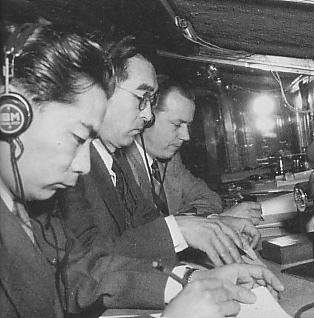Tokyo War Crimes Trial: Chronology

IMTFE interpreters working during the trial
June 1945
Anticipating an Allied invasion of Japan, Japan’s Foreign Ministry begins burning and shredding secret documents.
July 26, 1945
The United States, Britain, and China issue their Potsdam Declaration warning Japan of “prompt and utter destruction” unless Japan disarms, disbands its Empire, and removes its leaders.
August 6, 1945
A U.S. B-29 bomber drops an atomic bomb on Hiroshima.
August 9, 1945
A second atomic bomb is dropped, this time on Nagasaki.
August 10, 1945
In an imperial conference, Emperor Hirohito agrees with the prime minister that Japan should end the war.
August 15, 1945.
The war ends.
September 2, 1945
Aboard the USS Missouri, representatives of Japan formally sign surrender documents.
September 11, 1945
General Douglas MacArthur orders the arrest of 40 war criminals, including his main catch, Tojo Hideki. More arrests follow over the next few months.
September 27, 1945
MacArthur meets with Emperor Hirohito, who for politics reasons is not charged with war crimes.
October 4, 1945
MacArthur issues a civil liberties directive lifting restrictions on freedom of speech and assembly in Japan.
October 29, 1945
After MacArthur issued orders to try Japanese military leaders in the Philippines, General Yamashita Tomoyuki, commander of Japanese forces in the Philippines and considered by many to be Japan’s best general in the Pacific, is put on trial.
December 7, 1945
Yamashita is convicted not of ordering his troops to commit atrocities, but rather allowing the atrocities to happen.
January 19, 1946
MacArthur issues General Orders No. 1, establishing an international war crimes tribunal to try major Japanese war figures.
February 4, 1946
The U.S. Supreme Court rules, 7 to 2, in Yamashita’s appeal of his conviction, that the Manila court was lawful, that commanders had a duty to protect prisoners of war, and that the Court was without jurisdiction to hear Yamashita’s complaint about denial of due process.
February 23, 1946
Yamashita is hanged.
April 29, 1946
28 senior Japanese leaders ae indicted for war crimes ranging from waging an aggressive war to conventional war crimes.
May 3, 1946
The Tokyo War Crimes trial (with 26 defendants and 11 judges from Allied countries) opens at the former Army Ministry in central Tokyo.
May 17, 1946
The IMTFE rejects challenges by defense lawyers to the jurisdiction of the court and sets a trial date of June 3.
June 4, 1946
American prosecutor Joseph Keenan makes the opening statement for the prosecution.
January 24, 1946
After months of testimony, some it documentary and some of it emotional eyewitness testimony, the prosecution rests.
September 10, 1947
In the final phase of the defense case, individual defendants begin taking the stand to testify in their own behalf.
December 7, 1947
On the sixth anniversary of the bombing of Pearl Harbor, Emperor Hirohito gives a speech in which he promises Japan will never again pursue warlike policies.
December 17, 1947
Togo Shigenori, former foreign minister and perhaps the most tragic figure in the trial, takes the stand he calls the war “the great sorrow of my life.”
December 26, 1947
Tojo Hideki, the most compelling leader on trial, takes the stand. He unapologetically defends Japan’s war policies.
January 7, 1948
Tojo ends his testimony. He testifies, “I felt that I did what was right and true.’
April 16, 1948
After final summations, the Tokyo War Crimes trial adjourns.
November 2, 1948
After a summer of writing a judgment and sparring over language, the judges meet to decide the verdicts with respect to individual defendants.
November 4, 1948
The IMTFE convenes for the reading of its judgment and the announcement of its verdicts.
November 12, 1948
On the final day of trial, sentences are pronounced. All defendants are convicted on at least one count. Seven defendants, including Tojo, are sentenced to death.
November 24, 1948
General MacArthur, who had power to review the sentences, announces in a radio address that all sentences will stand.
December 6, 1948
The U.S. Supreme Court announces it will hear arguments concerning the motions of various defense attorneys for leave to file petitions for writs of habeas corpus.
December 14, 1948
In a per curium decision, the Supreme Court rules that it has no power to review the convictions of the court in Tokyo and denies the defense lawyers’ motions.
December 23, 1948
Shortly after midnight, the 7 convicted defendants that were sentenced to death are hanged in Sugamo Prison.
December 24, 1948
All 19 remaining unindicted Class A defendants are released and allowed to return to public life.
November 1950
The first convicted prisoner is freed by a parole board. By 1958, all convicted prisoners are paroled.
April 28, 1952
A peace treaty is signed restoring Japan as a sovereign country.
